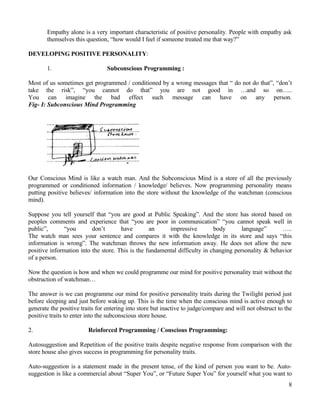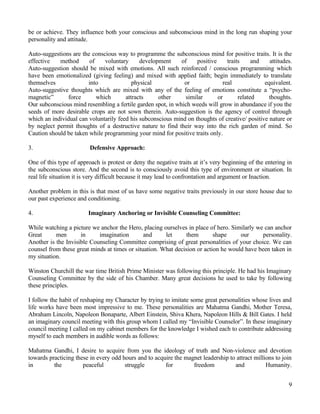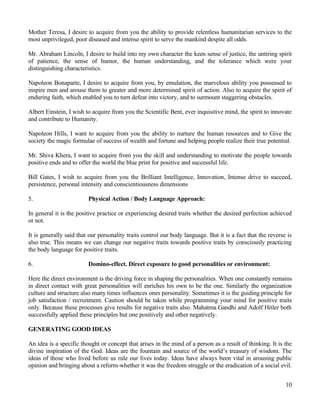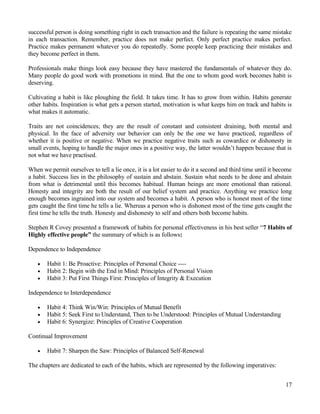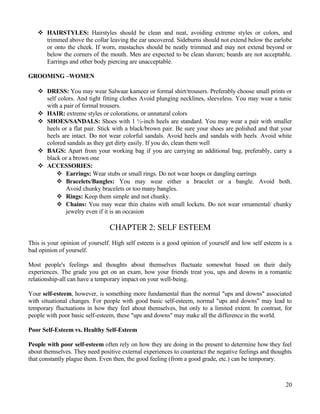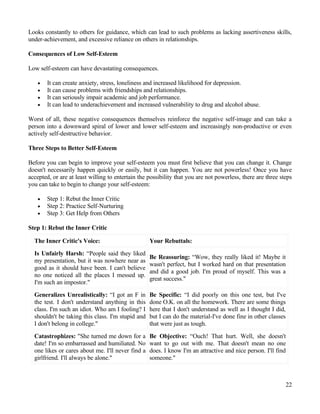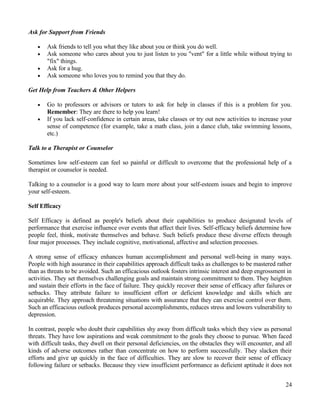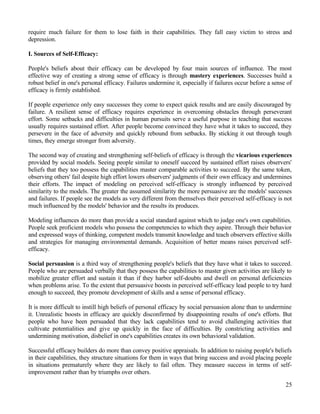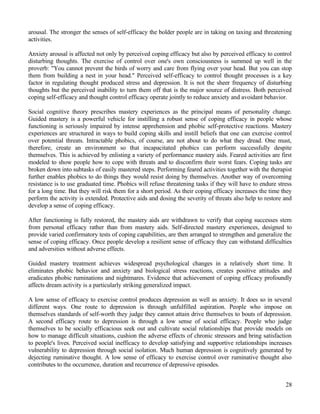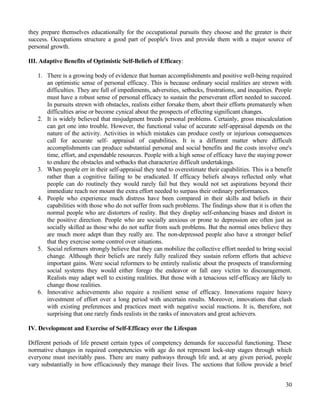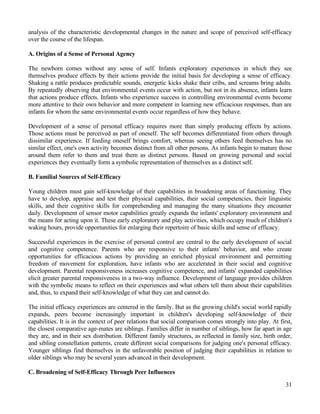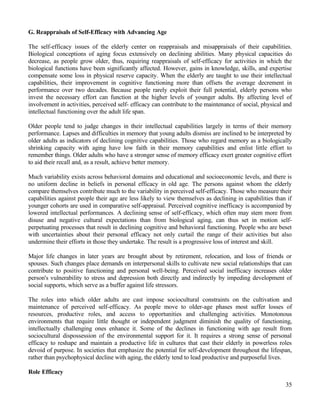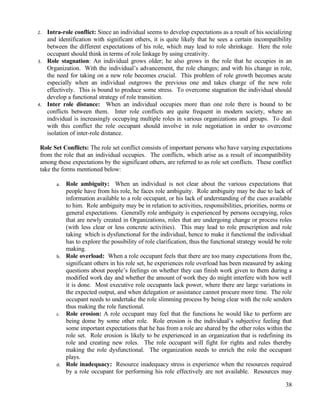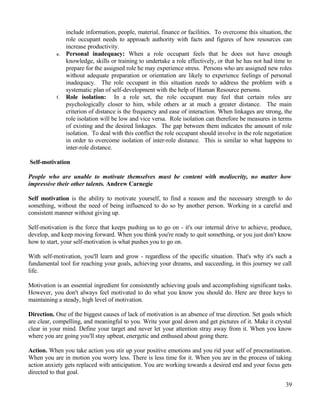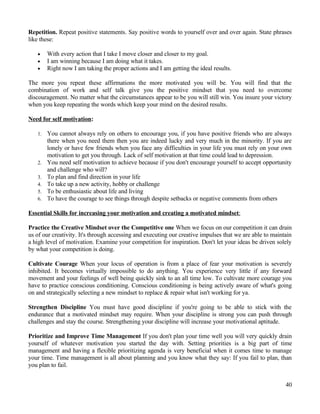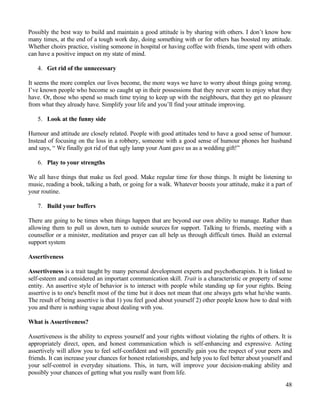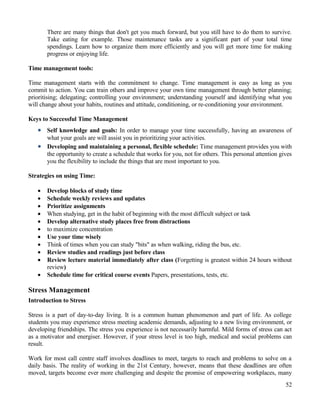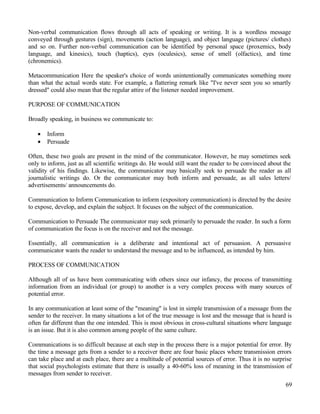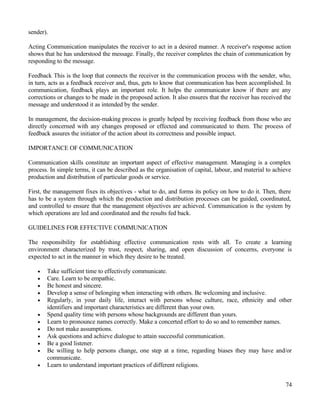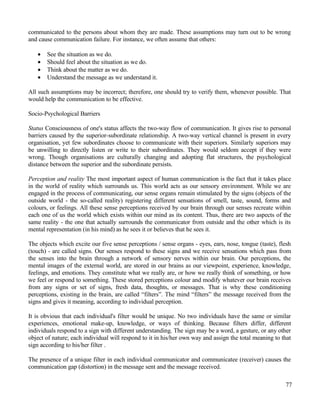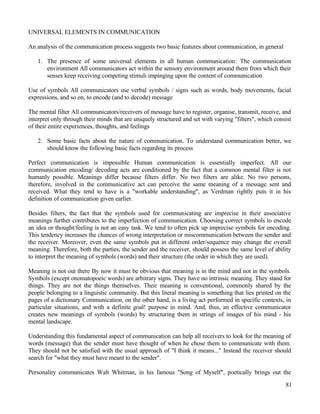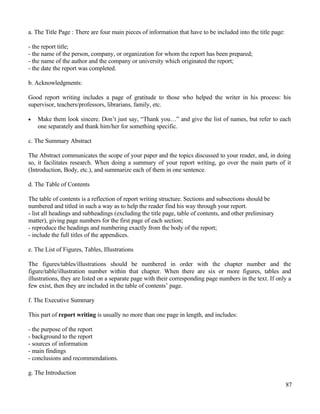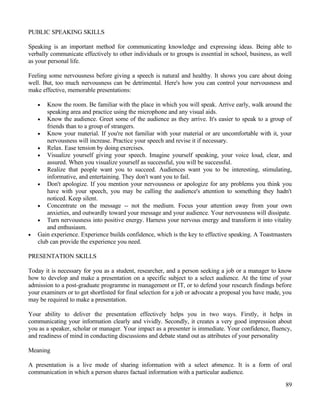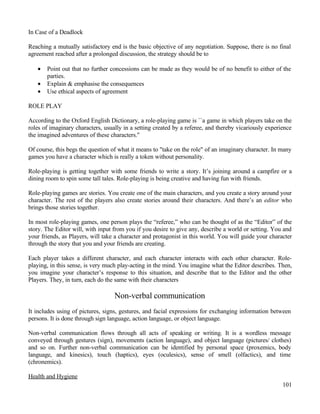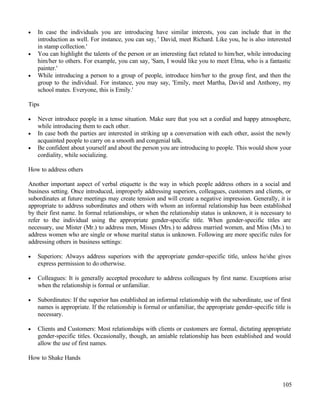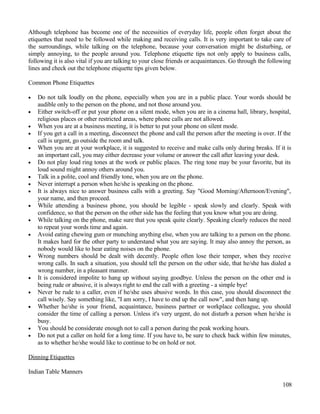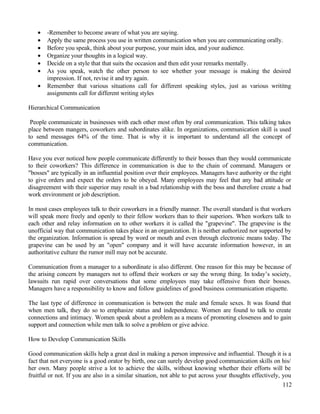Personality development study material by mr zeeshan nicks
- 1. PART 1 - PERSONALITY DEVELOPMENT CHAPTER 1: PERSONALITY Personality is the sum total of ways in which an individual reacts and interacts with others. Or Personality is generally defined as the deeply ingrained and relatively enduring patterns of thought, feeling and behavior. In fact, when one refers to personality, it generally implies to all what is unique about an individual, the characteristics that makes one stand out in a crowd. Personalities is the sum total of individual’s Psychological traits, characteristics, motives, habits, attitudes, beliefs and outlooks. Personality determinants: Heredity : Heredity refers to those factors that were determined at conception. Physical structure, facial attractiveness, gender, temperament, muscle composition and reflexes, energy level, and biological rhythms are characteristics that are generally considered to be either completely or substantially influenced by who your parents were, that is by their biological, physiological and inherent psychological makeup. Environment : The environmental factors that exert pressures on our personality formation are the culture in which we are raised, our early conditioning, the norms among our family, friends and social groups, and other influences that we experience. The environment to which we are exposed plays a substantial role in shaping our personalities. Situation : A third factor, the situation, influences the effects of heredity and environment on personality. An individual’s personality although generally stable and consistent, does change in different situations. The varying demand of different situation calls forth different aspects of one’s personality. We should not therefore look upon personality patterns in isolation. Self Awareness: Self Awareness knows your motivations; preferences, personality and understanding how these factors influence your judgment, decisions and interactions with other people. Through self-awareness one “develops the ability to know how you are feeling and why, and the impact your feelings have on your behaviour. But it involves a capacity to monitor and control those strong but subliminal biases that all us harbor and that skew our decision making”. Internal feelings and thoughts, interests, strengths and limitations, values, skills, goals, abilities, leadership orientation and preferred communication style are just a few elements that self awareness comprises. Benefits: Self-awareness or self-knowledge is the starting point for effectiveness at work. Machiavelli, the astute author and statesman, wrote, “ To lead or attempt to lead without first having a knowledge of self is foolhardy and sure to bring disaster and defeat.” Self-awareness has many benefits, among them. • Understanding yourself in relation to others • Developing and implementing a sound self-improvement program 1
- 2. • Setting appropriate life and career goals • Developing relationships with others • Understand the value of diversity • Managing others effectively • Increasing productivity • Increasing your ability to contribute to Organizations, your community and family. In others words it helps one to know what one is good at and choose a career they enjoy. Depending on others thoughts or beliefs in terms of what is good for us leads to personal and professional unhappiness. By knowing our strengths, weaknesses, likes and dislikes by ourselves - will help us know where we stand? Self-awareness is also important for managers and Organizations as one who have attained heightened states of self-awareness tend to be superior performers. This is because they can relate and understand others better and thus will be capable of reducing the potential of conflict. Usually this kind of person will be open to feedback and make positive modifications to personal behavior so as to create trusting and productive work environments. Working effectively with others will therefore increase managerial and Organizational effectiveness. Self-awareness is also a crucial component in understanding the Organization in which one is operating, as each of us can be thought of as an instrument for assessment and change. By asking us a series of questions we can diagnose our situation and develop some solutions to problems our Organizations or we are experiencing. Doing this requires strong self-awareness of our emotional reactions, initial perceptions, biases and judgments. Lack of self-awareness can lead to poor decisions, to an unrealistic notion of one’s competencies and to even career derailment. How to Gain? The first step in becoming aware of ourselves is to recognize our weaknesses, strengths, biases, attitudes, values and perceptions. There are many ways to enhance our self-awareness. Some of these include analyzing our own experiences, looking at ourselves through the eyes of others, self-disclosure, acquiring diverse experiences and increasing our emotional intelligence. • Self-analysis requires people to examine themselves as an object in an experience or event. It requires a person to step back and observe the positive and the negative impact that may have influenced behaviours, attitudes, thoughts or interactions. Self-analysis is not always an easy process, yet it is a necessary skill for synthesizing information relevant to professional or personal effectiveness. The self-analysis process should begin with reflection on and exploration of thoughts and feelings associated with effective events. By reflecting on these feelings and thoughts, individuals can obtain new perspectives relevant to their lives based on these learning experiences. From obtaining new knowledge and perspectives, individuals can become more effective by implementing new behavioural and cognitive changes in future situations. 2
- 3. One of the means to gain insight about our self is through reflecting on, examining and analyzing our behaviour, personality, attitudes and perceptions. o Behaviour is the way in which we conduct ourselves-the way in which we act. Our behaviour is influenced by our feelings, judgments, beliefs, motivations, needs, experience and opinions of others. Patterns of behaviour develop through our reactions to events and actions over a period of time. Behaviour consist of four components: Motivation: The drive to pursue one action over another. Being aware of our core drivers, those things that motivate you positively or negatively- can help you understand the roots of your behaviour and make adjustments as necessary to modify your behaviour. Modes of thinking: the way you process the various inputs your brain receives. Being aware of how you take in and make sense of information can help you understand how you make judgments or decisions that lead to choosing one behaviour or course of action over another. Modes of acting: the course of action you apply in a given situation. Being aware of how you express your reaction to the things that happen to and around you can help you understand the alternatives available to you when certain events arise. Modes of interacting: the way in which you communicate and share ideas, opinions and feelings with others. Being aware of how you talk and work with others can help you understand how your preferred style meshes with those with whom you work and live. o Personality: describes the relatively stable set of characteristics, tendencies and temperaments that have been formed by heredity and by social, cultural and environmental factors. These traits determine how we interact with and react to various people and situations. Some of the aspects of personality are believed to be a result of nature-those traits with which we are born and that we posses through heredity. Other characteristics of our personality are thought to be as a result of our environment-those factors that we acquire through exposure to people and events in our lives. Personality traits are enduring characteristics that describe an individual’s attitude and behaviour. Examples are agreeableness, aggression, dominance and shyness. Most of these traits have been found to be quite stable over time. This means a person who is cold and uncaring in one situation is likely to behave similarly in other situations. The “Big five” model is a powerful instrument because it organizes numerous concepts into a “short list” of just five factors that are representative of the characteristics that can be linked with satisfaction and success. The Big Five has five primary components: extroversion, agreeableness, emotional stability, conscientiousness and openness to experience. Extroversion: represents the degree to which an individual is social or antisocial, outgoing or shy, assertive or passive, active or inactive and talkative or quiet. A person who rates high for first traits in these pairs is extroverted, while someone who rates high for second traits is introverted. Extroversion or introversion, in itself, is not necessarily bad, but extremes at both the ends of the spectrum can be equally dysfunctional. A person who is too outgoing could be perceived as overbearing and a person who is too reserved would lack the skills to relate to others. 3
- 4. Agreeableness: measures the degree to which a person is friendly or reversed, cooperative or guarded, flexible or inflexible, trusting or cautious, good natured or moody, softhearted or tough and tolerant or judgmental. Those scoring high on the first element of these paired traits are viewed as more disagreeable and difficult to work with. Being too agreeable could cause a person to be too accommodating, however the others may take advantage of this weaknesses. Emotional Stability: characterizes the degree to which a person is consistent or inconsistent is how they react to certain events, reacts impulsively or weighs options before acting and takes things personally or looks at a situation objectively. Those who rate high on emotional stability are viewed as generally calm, stable having a positive attitude, able to manage their anger, secure, happy and objective. Those who rate low are more likely to be anxious, depressed, angry, insecure, worried and emotional. Conscientiousness: represents the degree to which an individual is dependable or inconsistent, can be counted on or is unreliable, follows through on commitments or are generally perceived to be careful, thorough, organized, persistent, achievement oriented, hardworking and persevering. Those who score lower on this dimension are more likely to be viewed as inattentive to detail, uncaring, disrespectful, not interested or motivated unorganized, apt to give up easily and lazy. Openness to experience: characterizes the degree to which people are interested in broadening their horizons or limiting them, learning new things or sticking with what they already know, meeting new people or associating with current friends and co-workers, going to new places or restricting themselves to known places. Individuals who score high on this factor tend to be highly intellectual, broad minded. Curious, imaginative and cultured. Those who rate lower tend to be more narrow minded, less interested in the outside world and uncomfortable in unfamiliar surroundings and situations. Professionals who are open to experience are more willing to reflect on feedback for personal development. Self-monitoring: is the tendency to adjust our behaviour relative to the changing demands of social situations. The concept of monitoring our own personality can help us come to grips with both those qualities we view as positive and those we would like to change. By being aware of the role of self-monitoring, we can assess our own behaviours and attitudes; diagnose which elements we are satisfied with, and identify and develop plans for addressing those aspects we want to change. When self-monitoring, it is important to want to set personal standards in accordance with certain accepted norms. High self-monitors are very sensitive to external cues and constantly adapt their true selves to conform to a situation or set of expectations. Low self-monitors are more consistent, displaying their feelings, attitudes and behaviours in every situation o Attitudes are evaluative statements or learned pre-dispositions to respond to an object, person or an idea in a favorable or unfavorable way. Attitudes are narrow in scope. They can vary from situation to situation. Strong attitudes can have an impact on professional and personal relationship. Our attitude can determine whether we think positively and take control of a situation or think negatively and feel helpless to change or respond to a situation. Our attitude is an important component of our ability to be productive at work. Our attitudes can influence people around us. Being aware of our own attitudes and making choices about which attitude to display to others is very important to us as individuals or as managers. Our attitude can affect our behaviour as well as our interaction 4
- 5. with others. Our friends, significant others, family members, co-workers and others are definitely influenced by our thought and feelings towards situations. As managers it is also important to recognize that our employees are affected by the attitudes we display towards them and towards the work that needs to get done. A manager’s attitude is a large factor in how people feel about their jobs. If a manager is upbeat most of the time and supportive of his or her colleagues, employees will generally respond well and work hard to produce the desired results. On the other hand if a manager is pessimistic and belittling towards his or her employees, staff morale will suffer and ultimately so will the expected outcomes. o Perceptions: Perception describes the process by which individuals gather sensory information and assign meaning to it. When we encounter a person or situation, we use our senses to absorb various inputs. Next our brains select aspects from stored information in order to process and organize these inputs. Finally our brains interpret and evaluate the person or situation. Individual perception may not always be consistent with reality; it is only perceiver’s interpretation of reality. Our perceptions are influenced by many factors, such as our culture, environment, heredity, the media, peers, past experiences, intelligence, needs, emotions, attitudes and values. Perception can be the result of multiple causality. As human beings we tend to form perceptions based on our biases. If we are not aware of our biases and don’t check our understanding with others, we might miss out on important information and situations by relying on distorted perceptions. Some of the more common filters are stereotyping, selective perception, projection expectation and interest. Other’s Perceptions about us is also viewed to be important, as we can understand how we are shaped by others opinions of us. This concept is referred to as social mirroring. By seeing ourselves through others eyes we can learn about our strengths and also about areas in which we can improve. Learning to read accurately how others see us enhances our “self-maps” our images and judgments of our self. • Self-disclosure: Another means of self-awareness is through self disclosure-sharing your thoughts, feelings and ideas with others without self-deception, without distortion. Talking to others allows to share our feelings and responses. Self-disclosure is a key factor in improving self-awareness; we must disclose information and interact with others to further clarify our perceptions. • Diverse Experiences: Another way of increasing self-awareness is through acquiring multiple experiences in diverse situations and with diverse others. As we encounter new situations, we use skills and acquire new ones, meet people and develop friendships, see new places and learn first hand about things we might have only read about. Being open to experiences broadens our horizons. It helps us to see ourselves in a new light while giving us new information about ourselves and our ability to interact with the world. This boosts our confidence level and encourages us to reach out to further our experiences even more. TRAITS FOR BUILDING POSITIVE PERSONALITY : 1. Accept Responsibility: The price of grateness is the responsibility – Winston Churchill “Responsibility gravitates to the person who can shoulder them.” -- Elbert Hubbard Society is not destroyed by the activities of the rascals, but by the inactivity of good people. 2. Show consideration : 5
- 6. Show consideration, courtesy, politeness and caring. 3. Think Win-Win : 4. Choose your words carefully: The principle is your speaking must be better than silent, rather be silent. Words spoken out of bitterness can cause irreparable damage. The way the parents speak to their children in many instances shapes their children’s destiny. 5. Never Criticize, Complain and Condemn 6. Smile and Be Kind : Smile is the shortest distance between two people. 7. Put Positive interpretation on other people’s behavior: We see the world not as it is, but as we are. So when we are interpreting other peoples behavior negatively we just reflecting our own mentality to this situation. In contrast when interpret positively, chances that other people may realize its negativity and change or amend this. 8. Be a Good Listener : Effective communication is 50% listening, 25% speaking, 15% reading and 10% writing. So when we listen carefully then 50% communication is done. 9. Be Enthusiastic : Nothing great was ever achieved without enthusiasm--- Ralph Waldo Emersion 10. Give honest and Sincere Appreciation : The desire to feel important is one of the greatest cravings in most of the human beings and it can be a great motivator. Honest and sincere appreciation makes one feel important and promote these positive qualities in him. In contrast giving false and insincere appreciation is flattery or sycophancy which in the long run is harmful to the receipient. 11. When you make a mistake, accept it and make it easy to amend: Mistakes are to be learned from. So accept it immediately and make change or amend easy. 12. Discuss but don’t argue: Arguing is like fighting a losing battle. Even if one wins in the argument, the cost may be more than the worth of victory. An Ignominious victory is a defeat itself. 13. Don’t Gossip: 6
- 7. Gossip may lead to slander and defamation of character. People who listen to gossip are as guilty as those who do the gossiping. 14. Turn your promises into commitment: Commitment leads to enduring relationship through thick and thin. It shows in a person,s personality and relationship. 15. Be grateful but do not expect gratitude: 16. Be dependable and practice loyalty: An ounce of loyalty is worth more than a pound of cleverness. Ability without dependability is of no worth. 17. Avoid bearing grudges: Life is too small to bear grudges. John Kennedy once said “forgive the other person but don’t forget their name.” Means “if one cheated me once it is his fault, but if cheats me wice then it is my fault.” Don’t be cheated regularly to forgive. 18. Practice honesty, Integrity and Sincerity: Lies may have speed, but the truth has endurance. Honesty, Integrity and Sincerity have more enduring effect than the opposite. 19. Practice Humility: Confidence without humility is arrogance. Sincere Humility is the foundation of all virtues. It is a sign of greatness. 20. Be understanding and Caring : The best way to be understood is to be understanding. And the basis of real communication is also understanding. 21. Practice courtesy on daily basis : 22. Develop a sense of humor: Have a sense of humor and you will possess the ability to laugh at yourself. A sense of humor makes a person likeable and attractive. Some people are humor-impaired. 23. Don’t be sarcastic and put others down : 24. To have a friend be a Friend : Mutual trust and confidence are the foundation stones of all friendship. 25. Show Empathy : 7
- 8. Empathy alone is a very important characteristic of positive personality. People with empathy ask themselves this question, “how would I feel if someone treated me that way?” DEVELOPING POSITIVE PERSONALITY: 1. Subconscious Programming : Most of us sometimes get programmed / conditioned by a wrong messages that “ do not do that”, “don’t take the risk”, “you cannot do that” you are not good in …and so on….. You can imagine the bad effect such message can have on any person. Fig- I: Subconscious Mind Programming Our Conscious Mind is like a watch man. And the Subconscious Mind is a store of all the previously programmed or conditioned information / knowledge/ believes. Now programming personality means putting positive believes/ information into the store without the knowledge of the watchman (conscious mind). Suppose you tell yourself that “you are good at Public Speaking”. And the store has stored based on peoples comments and experience that “you are poor in communication” “you cannot speak well in public”, “you don’t have an impressive body language” ….. The watch man sees your sentence and compares it with the knowledge in its store and says “this information is wrong”. The watchman throws the new information away. He does not allow the new positive information into the store. This is the fundamental difficulty in changing personality & behavior of a person. Now the question is how and when we could programme our mind for positive personality trait without the obstruction of watchman… The answer is we can programme our mind for positive personality traits during the Twilight period just before sleeping and just before waking up. This is the time when the conscious mind is active enough to generate the positive traits for entering into store but inactive to judge/compare and will not obstruct to the positive traits to enter into the subconscious store house. 2. Reinforced Programming / Conscious Programming: Autosuggestion and Repetition of the positive traits despite negative response from comparison with the store house also gives success in programming for personality traits. Auto-suggestion is a statement made in the present tense, of the kind of person you want to be. Auto- suggestion is like a commercial about “Super You”, or “Future Super You” for yourself what you want to 8
- 9. be or achieve. They influence both your conscious and subconscious mind in the long run shaping your personality and attitude. Auto-suggestions are the conscious way to programme the subconscious mind for positive traits. It is the effective method of voluntary development of positive traits and attitudes. Auto-suggestion should be mixed with emotions. All such reinforced / conscious programming which have been emotionalized (giving feeling) and mixed with applied faith; begin immediately to translate themselves into physical or real equivalent. Auto-suggestive thoughts which are mixed with any of the feeling of emotions constitute a “psycho- magnetic” force which attracts other similar or related thoughts. Our subconscious mind resembling a fertile garden spot, in which weeds will grow in abundance if you the seeds of more desirable crops are not sown therein. Auto-suggestion is the agency of control through which an individual can voluntarily feed his subconscious mind on thoughts of creative/ positive nature or by neglect permit thoughts of a destructive nature to find their way into the rich garden of mind. So Caution should be taken while programming your mind for positive traits only. 3. Defensive Approach: One of this type of approach is protest or deny the negative traits at it’s very beginning of the entering in the subconscious store. And the second is to consciously avoid this type of environment or situation. In real life situation it is very difficult because it may lead to confrontation and argument or Inaction. Another problem in this is that most of us have some negative traits previously in our store house due to our past experience and conditioning. 4. Imaginary Anchoring or Invisible Counseling Committee: While watching a picture we anchor the Hero, placing ourselves in place of hero. Similarly we can anchor Great men in imagination and let them shape our personality. Another is the Invisible Counseling Committee comprising of great personalities of your choice. We can counsel from these great minds at times or situation. What decision or action he would have been taken in my situation. Winston Churchill the war time British Prime Minister was following this principle. He had his Imaginary Counseling Committee by the side of his Chamber. Many great decisions he used to take by following these principles. I follow the habit of reshaping my Character by trying to imitate some great personalities whose lives and life works have been most impressive to me. These personalities are Mahatma Gandhi, Mother Teresa, Abraham Lincoln, Napoleon Bonaparte, Albert Einstein, Shiva Khera, Napoleon Hills & Bill Gates. I held an imaginary council meeting with this group whom I called my “Invisible Counselor”. In these imaginary council meeting I called on my cabinet members for the knowledge I wished each to contribute addressing myself to each members in audible words as follows: Mahatma Gandhi, I desire to acquire from you the ideology of truth and Non-violence and devotion towards practicing these in every odd hours and to acquire the magnet leadership to attract millions to join in the peaceful struggle for freedom and Humanity. 9
- 10. Mother Teresa, I desire to acquire from you the ability to provide relentless humanitarian services to the most unprivileged, poor diseased and intense spirit to serve the mankind despite all odds. Mr. Abraham Lincoln, I desire to build into my own character the keen sense of justice, the untiring spirit of patience, the sense of humor, the human understanding, and the tolerance which were your distinguishing characteristics. Napoleon Bonaparte, I desire to acquire from you, by emulation, the marvelous ability you possessed to inspire men and arouse them to greater and more determined spirit of action. Also to acquire the spirit of enduring faith, which enabled you to turn defeat into victory, and to surmount staggering obstacles. Albert Einstein, I wish to acquire from you the Scientific Bent, ever inquisitive mind, the spirit to innovate and contribute to Humanity. Napoleon Hills, I want to acquire from you the ability to nurture the human resources and to Give the society the magic formulae of success of wealth and fortune and helping people realize their true potential. Mr. Shiva Khera, I want to acquire from you the skill and understanding to motivate the people towards positive ends and to offer the world the blue print for positive and successful life. Bill Gates, I wish to acquire from you the Brilliant Intelligence, Innovation, Intense drive to succeed, persistence, personal intensity and conscientiousness dimensions 5. Physical Action / Body Language Approach: In general it is the positive practice or experiencing desired traits whether the desired perfection achieved or not. It is generally said that our personality traits control our body language. But it is a fact that the reverse is also true. This means we can change our negative traits towards positive traits by consciously practicing the body language for positive traits. 6. Domino-effect. Direct exposure to good personalities or environment: Here the direct environment is the driving force in shaping the personalities. When one constantly remains in direct contact with great personalities will enriches his own to be the one. Similarly the organization culture and structure also many times influences ones personality. Sometimes it is the guiding principle for job satisfaction / recruitment. Caution should be taken while programming your mind for positive traits only. Because these processes give results for negative traits also. Mahatma Gandhi and Adolf Hitler both successfully applied these principles but one positively and other negatively. GENERATING GOOD IDEAS An idea is a specific thought or concept that arises in the mind of a person as a result of thinking. It is the divine inspiration of the God. Ideas are the fountain and source of the world’s treasury of wisdom. The ideas of those who lived before us rule our lives today. Ideas have always been vital in arousing public opinion and bringing about a reform-whether it was the freedom struggle or the eradication of a social evil. 10
- 11. Theosophical ideas have the ability to change the inner nature of man and have the power to transform beast into human, human into divine man. The four letter word ‘idea’ has great potential and it has immense powers surrounding it. As thoughts fleet over the filter of logical reasoning, idea would percolate and gradually crystallize into a clear screen of clear vision enabling the man to look through problems and to judge issues judiciously. It is this mind- boggling strength of ideas which facilitates our decision-making. Ideas give confidence to face this competitive world. It is the idea which makes all the difference between floating and sinking of a person’s fortune in this competitive world. Like radar which guides the ship in the vast ocean, idea gives us the direction to proceed and the goal to attain. It is that magical key which unlocks all the closed doors, solves all our queries and enables us to achieve our desired goals. No wonder it is this power of idea that is shaping the dreams of life and guiding the course of human civilization. Ideas rule the world and thoughts rule your life. Whatever you think, that you become. If you think yourselves weak, weak you will be; if you think yourselves strong, strong you will be. The remedy of weakness is not brooding over weakness, but thinking of strength. It is your idea which moulds your destiny. Believe in the power of idea to change things Banish all self-doubts, resentment, guilt complex and you will find strength, vitality, joy and success come rushing in and literally flooding you with superb achievements. Sooner or later, one who wins is the one who thinks and believes he can. “Great ideas and convictions are the mother of great deeds”. Success starts with an idea. When nourished with hope and confidence and encouraged by ambition and aspiration, that single idea takes shape as a dream, vision, and goal in stages. You must allow your ideas to grow, no matter how farfetched or nonconformist they may seem in the beginning. You must give wings to you ideas and let them fly high. You must allow your thoughts to take root, no matter how others regard them. Many great ones, whom the world today worships with awe and wonder as gifted visionaries, super geniuses or miracle-makers, were viewed as utopians or mental defunct by several of their contemporaries. While some may describe your ideas an imagination and vision, others may dub them as sheer daydreams and idle fantasies. But the fact remains that ideas, however strange, unorthodox or heretic they might have seemed at the start, have ultimately wrought miracles, brought revolutions and built civilization. Every idea worth considering. Most ideas are worthy of action. The most tragic waste is the waste of a good idea. I ask you now “Is there some great idea in your life that you have still have not dealt affirmatively ?” A far more important question is this : How do you treat ideas ? Treat the ideas like new born babies : Treat them tenderly, They can get killed pretty quickly. Treat them gently, They can be bruised in infancy. 11
- 12. Treat them respectfully, They could be most valuable things that ever came into your life. Treat them protectively …. Don’t let them get away. Treat them nutritionally…. Feed them and feed them well. Treat them antiseptically…. Don’t let them get infected with the germs of negative thought. Treat them responsively, Respond; Act ; Do something with them. To achieve results even the most brilliant ideas should be translated into action by systematic, sustained and dedicated effort. Without effort, our ideas will gather dust, get rusted and go to waste. The success stories of great men illustrate that they used intelligence and industry in equal measure to gain their coveted goals. Ideas rule the world and they primarily emanate from poets and philosophers, from mystics and occultists. These great ideas make most suitable foundations. Once their efficacy is experienced in application by an individual he leaves behind the world of chaos and strife and begins to glimpse a world of order, understanding and peace. Right ideas and right philosophy is the dire need of our age. Strong idea is an outcome of strong faith in oneself and spiritual strength. In the times of trial, when darkness and despair surround you, when failure confronts you, when sorrow prevails, when life appears meaningless-it is that strong idea and conviction which illuminates yours life with a ray of hope. It is this strength of idea which instills an urge to live life in this fullest form and not merely survive. It’s the idea which helps us attain a state of bliss and satisfaction. Ideas bring light and enlightenment which help to dispel darkness, eliminate prejudices and cobwebs of superstition. They also lead sooner or later to the emergence of truth. Ideas in fact, are mightier than armies, that is, why ideologies and convictions have achieved more victories than horseman and chariots. By providing inspiration, ideas work through the arms and vigour of brave men. The man strongly possessed of an idea is the master of all who are uncertain and wavering. Clear, deep living convictions rule the world. Today, the people who reach the zenith are no exceptions. It is the only through their day-to-day ideas acquired through knowledge and perseverance which makes them exceptional and only these exceptions claim respect and status in society which is nothing but ‘power’. It has been seen from time immemorial that a knowledgeable person commands respect. In the Court of Akbar, Birbal acquired a supreme position because of his ides and intelligence. Even Chanakya was an excellent administrator and with his administrative ideas as an astute political. He was instrumental in overthrowing the rule of Nanda Dynasty and installing Chandragupta Maurya as the ruler of the state. Indeed, idea commands power, position and prestige. Dr. A.P.J. Abdul Kalam, President and father of 12
- 13. India’s Missile Technology, has made India feel so proud and nuclear self-sufficient. This is all because of his ideas. Dr. Hargobind Khorana was credited with deciphering genetic code, and it was a major landmark in the story of Genetics. The ideas in the field of computer has today revolutionized the entire world. It is the idea and knowledge of Microsoft supremo Bill Gates, which has made him the most powerful, respectable and richest person in the world. Not only in the world of science, the worth and power of ideas cannot be underestimated in any other sphere whether it is stock market or sports. Share markets provide an excellent opportunity for investors to make a quick back, but here only a few investors who have proper ideas and knowledge of the game earn handsome profits whereas other with little knowledge are likely to lose. Even in sports, some sports personalities excel over others. Leander Paes, Mahesh Bhupathi, Sania Mirza,Viswanathan Anand, Kapil Dev, Sachin Tendulkar, to name a few, are world renowned players. They have achieved greater heights which their seniors, though having more of the game, could not. This is primarily due to greater interest, determination, intense knowledge and perfect idea of the game. Before a game is actually played in the field, it has to be played in the mind. Only a correct strategy, well organized mind demarcates a winner from a loser. Because of their ideas and expertise, such players are ruling the world of sports. It was the spiritual ideas of Gautam Buddha which led Ashoka to abjure the path of bloodshed and adopt non-violence or Ahimsa. Ramakrishna Paramhansa and Vivekananda acquired knowledge and ideas through long hours of meditation and due to this people not only from entire India, but from many parts of the world, followed their teachings and worshipped them like God. Ideas verify rule the world, and also the minds of men; they contribute to continuing changes, shape as well as determine the destiny of human beings and contribute to the growth of civilizations. Every great and grand accomplishment, whether relating to religion, science, medicine, industry of technology, which are written in letters of gold in the history of human advancement, was in the first instance, no more than a mere idea in the mind of a human being, be he a man or women, Reversed religious texts, great classics, magnificent monuments, astonishing scientific discoveries, earthshaking inventions, fantastic technological feats like splitting the atom, heart transplant, humans walking on the Moon, unraveling the secrets of Mars - have all hand only ‘ideas’ at their starting points. BE POSSIBILITY THINKER… LOOK EVERY IDEA AS PROSPECT. Possibility thinker looks at every idea to see if it has possibilities. If it does, he takes an option out on the idea. He does not let it slip by. Ideas are the fruits of our thinking. But they have got to be harnessed and put to work to have value. Very few ideas become successful as they are highly perishable. If you were not on guard, the squirrels (- ve thinking people) will destroy most of these. Ideas require special handling as mentioned above until they are transformed into practical ways of doing things better. USE THREE WAYS TO HARNESS AND DEVELOP YOUR IDEAS 1. Write down every ideas come to your mind : Everyday lots of good ideas are born only to die quickly because they aren’t nailed to paper. Memory is a weak slave when itcomes ot preserving and nurturing brand new ideas. Carry a note book or some small card with you all the time, when you get an idea, write it down. People with firtile and creative mind know a good idea may sprout any time, any place. Don’t let ideas escape, else you destroy the fruits of your thinking. 13
- 14. 2. Next- review your Ideas : File these ideas in an active file. The file can be an elaborate cabinet or it can be a desk drawer. A show box will do. But build a file and then examine your store house of ideas regularly. As you go over your ideas some may for very good reason have no value at all. Get rid of these. But so long as the idea has any promise, keep it. 3. Cultivate and Fertilise your ideas : Now make you ideas grow. Think about it. Tie the ideas to related ideas. Read anything you can find which is in any way is akin to your ideas. Investigate form all angles. Then when the time is ripe put it to work for yourself, your job, your future. NEVER THROW AN IDEA JUST BECAUSE IT IS IMPOSSIBLE, GIVE IT A CHANCE...... 1. Never reject a possibility because you see something wrong with it 2. Never reject a possibility because you would not get the credit: Don’t worry about getting the credit. If you do, you will become ego-involved in the decision making moments of life. Decisions must never be based on ego needs. 3. Never reject an idea because it is impossible: Almost every great idea is impossible when it is first born. The great idea today are yet impossible. Possibility thinker take great ideas and turn the impossibilities into possibilities. That is the progress. The important issue is whether the idea is good one. Would it help people who are hurting? Would it be a great thing for our country and our world? If so develop a way to achieve what today is impossible. 4. Never reject a possibility because your mind is already made up : People who never change their mind either perfect of stubborn. I am not perfect neither you are. 5. Never reject an idea because it is illegal : You might be able to get the law changed. 6. Never reject an idea because you don’t have the money, manpower, muscles or months to achieve it : A supersuccessful person has very few resources, except the capacity to take an idea and marshal stronger and smarter people around him to pull it off. 7. Never reject an idea because it will create conflict : To reject an idea because it may generate conflict is to ‘Surrender leadership to friends or foe. 8. Never reject an idea because it is not your way of doing things : Learn to accommodate. Prepare to compromise. Plan to adjust. Maintain a balance between the tension of an opportunity that demand exploitation and the limitation of resources available at the moment. Learn to be equilibristic. Readjust your budget. Compromise your taste. Accommodate your life style. It is more important to succeed than it is to snobbishly adhere to your private taste. 9. Never reject an idea because it might fail : There is risk in everything. One thing world needs more than anything else today is possibility thinking. Success is never certain and failure is never final You never reject an idea because there is some risks involved: You isolate the risk, insulate it, and eventually eliminate it. 10. Never reject an idea because it is sure to succeed. :- All the fellow spiritual / religious people who say, "I should not try to be successful. I am not trying for top ladder. That is vanity. That is materialistic." I must say that is not true, to choose poverty instead of prosperity, failure instead of success, low achievement instead of top ladder achievement, simply for the sake of being humble is not super religious. It is dumb. 14
- 15. Only successful people help people who are failing. Only winners will survive to give food to the hungry. Habits Daily habits might not be too hard, but what about those habitual behaviors that you dislike; These are the habits that are hard to change. A habit is an activity that is acquired, done frequently, done automatically, and difficult to stop. Most people think of behaviors when they think of habits, but thoughts can also become habits. Sometimes our habitual thinking can keep habitual behaviors going and make them hard to change. We’ll be discussing thinking habits quite a bit here. Habits can be good or bad. Good habits help us get through our daily lives. When we drive, we use a number of habits – behaviors that are acquired and done automatically. Stopping at red lights, slowing down when going through a school zone, buckling seat belts. These are all good habits that protect us when we drive. Of course, we can also develop some pretty bad habits, ones that can be harmful to us, and to other people. Speeding through red lights and school zones and driving without a seat belt are examples of bad habits. In general, habit is recurrent, often unconscious pattern of behavior that is acquired through frequent repetition. An established disposition of the mind or character. We tend to think of habits as things we do and we categorize them as good or bad. Brushing our teeth every morning (good habit) or smoking (bad habit). In truth a habit is a complicated set of thoughts, emotions and behaviors that we repeat often enough that it becomes engrained in our brains at a level where conscious thought or choice is no longer really necessary. All of our habits began as thoughts, even if it was a thought like “Oh, wouldn’t I look cool smoking a cigarette”. When you first started, that thought might have supported your commitment to fitting in with your peers or feeling mature. Over time, your commitments may have shifted and the smoking habit no longer supports you. It can help to think in terms of habits that support or don’t support your highest goals for yourself when you are thinking of changing a long-held behavior that has become habit. Instead of Changing a Habit, Create a New One. If you were to look at an EEG of your brain while you are brushing your teeth, you would see a line of neurons lighting up in a particular pattern. Every time you brush your teeth, or evening imagine brushing your teeth, that same line of neurons lights up. The same thing happens with your habitual thoughts. When you think “I’m too tired to get out of bed and exercise today”, if that is something that you often think when you imagine getting up to exercise, that thought is habitual and you would be able to see the neuron path of the thought in your brain with an EEG. So changing habits requires rewiring the brain, retraining the pathway of the neurons to line up with something new. It can help if you think in terms of starting a new pathway, rather than trying to change an old one. Instituting a new habit can take as little as 30 days of consistent repetitive behavior, whereas breaking an old habit, especially if there are addictive/chemical components involved, can take much longer. Start Small: 15
- 16. Most people want to get to the end result so quickly that they skip steps or place unrealistic expectations on themselves. Then when the results don’t happen, they walk away defeated and the volume of their inner critic’s voice gets really loud. Just think about your unsuccessful New Year’s resolutions. For example, if you set a New Year’s resolution to “get healthy” which included things such as eating right, exercising regularly, and quitting cigarettes or alcohol you might have gone full speed ahead for a few weeks and then something happened and you skipped a day of exercise. That led to a lot of negative self-talk about how you “blew it” and it “proved” that you’ll never get healthy - so you gave up on it all and ordered a pizza and drank a beer. Trying to change too many things at once is a recipe for failure because it’s unrealistic that we can change a habit we’ve had for years overnight – let alone two or three habits at the same time! Human beings are creatures of habit – and making changes doesn’t come easily. This is true not because we’re bad or incapable, but because making changes that last occurs at a very deep level – at the root of our thoughts and beliefs. It takes consistent new action over a period of time to reinforce the new way of thinking. Perhaps your New Year’s resolution was simply to “exercise regularly.” You bought the cutest workout clothes, new sneakers, and joined a gym. Even though you’d been a couch potato for years, you pushed yourself that first week by running 3 miles and lifting weights that were way too heavy…and you pulled a muscle – which then forced you to recover for a week or two. By the time you recovered, your enthusiasm had waned and you couldn’t seem to get back gym. Sound familiar? Skipping steps is recipe for failure because changes that last are built upon a solid foundation. Taking small, consistent action every day builds inner strength and the capacity to integrate the natural effects of your new behavior, which also gives you the time to integrate and get comfortable with your new way of thinking. New beliefs = new actions = new results. By keeping it simple, choosing one place to start, and making the action doable - you are setting yourself up to win. There is no urgency when it comes to your new habit. You are not in a race - you’re on a journey and choosing the one part of the new habit that most appeals to you is the perfect place to start! How to get started on your new habit? 1. Think of the habit as something that will support your highest goals for yourself. 2. Think in terms of creating a new habit instead of breaking an old one. 3. Start small. Think of one new habit you want to instill and begin there. 4. Start at the level of your thought. If you want to start a habit of healthy eating, spend 30 days practicing this thought every day: “I am a healthy eater, and I love choosing foods that support my vitality”. Spend this time before you do any action and you will find yourself with a solid foundation from which to shift your actual behavior. FORMING GOOD HABITS: We are all born to lead successful lives but our conditioning leads us to failure. We are born to win but are conditioned to lose. We often hear statements like, this person is just lucky, he touches dirt and turns to gold. Or he is unlucky, no matter what he touches, it runs to dirt. This is not true. If you analyse, the 16
- 17. successful person is doing something right in each transaction and the failure is repeating the same mistake in each transaction. Remember, practice does not make perfect. Only perfect practice makes perfect. Practice makes permanent whatever you do repeatedly. Some people keep practicing their mistakes and they become perfect in them. Professionals make things look easy because they have mastered the fundamentals of whatever they do. Many people do good work with promotions in mind. But the one to whom good work becomes habit is deserving. Cultivating a habit is like ploughing the field. It takes time. It has to grow from within. Habits generate other habits. Inspiration is what gets a person started, motivation is what keeps him on track and habits is what makes it automatic. Traits are not coincidences; they are the result of constant and consistent draining, both mental and physical. In the face of adversity our behavior can only be the one we have practiced, regardless of whether it is positive or negative. When we practice negative traits such as cowardice or dishonesty in small events, hoping to handle the major ones in a positive way, the latter wouldn’t happen because that is not what we have practised. When we permit ourselves to tell a lie once, it is a lot easier to do it a second and third time until it become a habit. Success lies in the philosophy of sustain and abstain. Sustain what needs to be done and abstain from what is detrimental until this becomes habitual. Human beings are more emotional than rational. Honesty and integrity are both the result of our belief system and practice. Anything we practice long enough becomes ingrained into our system and becomes a habit. A person who is honest most of the time gets caught the first time he tells a lie. Whereas a person who is dishonest most of the time gets caught the first time he tells the truth. Honesty and dishonesty to self and others both become habits. Stephen R Covey presented a framework of habits for personal effectiveness in his best seller “7 Habits of Highly effective people” the summary of which is as follows: Dependence to Independence • Habit 1: Be Proactive: Principles of Personal Choice ---- • Habit 2: Begin with the End in Mind: Principles of Personal Vision • Habit 3: Put First Things First: Principles of Integrity & Execution Independence to Interdependence • Habit 4: Think Win/Win: Principles of Mutual Benefit • Habit 5: Seek First to Understand, Then to be Understood: Principles of Mutual Understanding • Habit 6: Synergize: Principles of Creative Cooperation Continual Improvement • Habit 7: Sharpen the Saw: Principles of Balanced Self-Renewal The chapters are dedicated to each of the habits, which are represented by the following imperatives: 17
- 18. 1. Habit 1 - Principles of Personal Choice: Covey emphasizes the original sense of the term "proactive" as coined by Victor Frank. You can either be proactive or reactive when it comes to how you respond to certain things. When you are reactive, you blame other people and circumstances for obstacles or problems. Being proactive means taking responsibility for every aspect of your life. Initiative and taking action will then follow. Covey also argues that man is different from other animals in that he has self-consciousness. He has the ability to detach himself and observe his own self; think about his thoughts. He goes on to say how this attribute enables him: It gives him the power not to be affected by his circumstances. Covey talks about stimulus and response. Between stimulus and response, we have the power of free will to choose our response. 2. Habit 2 - Principles of Personal Vision: This chapter is about setting long-term goals based on "true north" principles. Covey recommends formulating a "Personal Mission Statement" to document one's perception of one's own vision in life. He sees visualization as an important tool to develop this. He also deals with organizational mission statements, which he claims to be more effective if developed and supported by all members of an organization rather than prescribed. 3. Habit 3 - Principles of Integrity & Execution: Covey describes a framework for prioritizing work that is aimed at long-term goals, at the expense of tasks that appear to be urgent, but are in fact less important. Delegation is presented as an important part of time management. Successful delegation, according to Covey, focuses on results and benchmarks that are to be agreed in advance, rather than on prescribing detailed work plans. 4. Habit 4 - Principles of Mutual Benefit: An attitude whereby mutually beneficial solutions are sought that satisfy the needs of oneself as well as others, or, in the case of a conflict, both parties involved. 5. Habit 5 - Principles of Mutual Understanding: Covey warns that giving out advice before having empathetically understood a person and their situation will likely result in that advice being rejected. Thoroughly listening to another person's concerns instead of reading out your own autobiography is purported to increase the chance of establishing a working communication. 6. Habit 6 - Principles of Creative Cooperation: A way of working in teams. Apply effective problem solving. Apply collaborative decision making. Value differences. Build on divergent strengths. Leverage creative collaboration. Embrace and leverage innovation. It is put forth that when synergy is pursued as a habit, the result of the teamwork will exceed the sum of what each of the members could have achieved on their own. “The whole is greater than the sum of its parts.” 7. Habit 7 - Principles of Balanced Self-Renewal: Focuses on balanced self-renewal: Regain what Covey calls "production capability" by engaging in carefully selected recreational activities. Covey also emphasizes the need to sharpen the mind. In today's challenging and complex world, being highly effective is the price of entry to the playing field. To thrive, innovate, excel, and lead in this new reality, we must reach beyond effectiveness toward fulfillment, contribution, and greatness. Research is showing, however, that the majority of people are not thriving. They are neither fulfilled nor excited. Tapping into the higher reaches of human motivation requires a new mindset, a new skill-set --a new habit. Dr. Covey's new book, The 8th Habit: From Effectiveness to Greatness, is a roadmap to help you find daily fulfillment and excitement. PERSONAL GROOMING Grooming means dressing well, to be presentable to others. You may want to give a little more attention to how you dress at work because what you wear may be substantially influencing your career path. Although nothing takes the place of talent, hard work, innate ability and ambition, looking your 18
- 19. professional best in the workplace can give you a Competitive advantage. It simply means dressing in a way that projects an image of the sophisticated, successful working individual you are or would like to become. When you are fresh and well groomed, it creates a positive impression. Research has shown that good looking people have a 20% advantage over the not so groomed ones. If you are a genius, perhaps you can get away with anything. If you are not, though, here are some basic rules to conform to: 1. Daily showers are a necessity. 2. Hair must be shampooed at least once in 2 days and conditioned once a week. 3. A hairstyle to suit your face and personality must be chosen. 4. Eyes, nose and ears need to be cleaned in privacy and not in public. 5. Teeth need brushing and flossing every morning and night, and rinsing after every meal. Make sure not to eat any pungent food during office hours. If you do, rinse your mouth thoroughly and eat some mouth freshener. 6. Nails should be clipped and filed short for men and be of medium length for women. It is understood that medium length nails have to be clean and if painted, the enamel should not be chipped. Bright and zany nails are great for parties but not for work. 7. Toes and feet too should be taken care of. The feet should be kept clean and crack free. The toenails should go through a routine of cleaning. Ladies can paint them in mild colours for work and try and have a pedicure once every fortnight. GROOMING –MEN DRESS: As a rule, the simpler the better. SHIRTS Colours: White, off white, pale, blue shirts are preferred; though you may wear dark colored shirts too.(given below are the colours preferred by professionals). It is important to button up your shirt till the collar button TROUSERS: They should preferably be dark though you may wear beige and with a dark colored shirt. Try to have at least one pair of black trousers Trousers may or may not have pleats TIES: To play it safe choose a traditional silk tie, No loud colours or patterns. Given below are some well accepted colour sand patterns…you may be wise to avoid ties with images and designer logos Your tie should co-ordinate with your attire the knot should be a perfect triangle… Do not enter a clinic like this (observe the tie and the shirt button) SOCKS: Choose a color that coordinates with your trousers (usually black, dark gray, dark brown or dark blue) Make sure they are long enough not to expose your skin when you sit down. As a thumb rule, do not wear white socks. Wear clean socks to avoid bad odour SHOES: Wear a good pair of leather shoes-black and brown/tan shoes. Shoes must be polished everyday Do not wear shoes that look casual. Also, do not wear shoes with worn out heels. BELTS: Wear only formal belts with a sleek buckle. As thumb rule, match your belt to your shoes. WATCHES: Preferably wear leather strapped watches. If you wear a metal strapped watch, make sure that it fits the wrist well 19
- 20. HAIRSTYLES: Hairstyles should be clean and neat, avoiding extreme styles or colors, and trimmed above the collar leaving the ear uncovered. Sideburns should not extend below the earlobe or onto the cheek. If worn, mustaches should be neatly trimmed and may not extend beyond or below the corners of the mouth. Men are expected to be clean shaven; beards are not acceptable. Earrings and other body piercing are unacceptable. GROOMING –WOMEN DRESS: You may wear Salwaar kameez or formal shirt/trousers. Preferably choose small prints or self colors. And tight fitting clothes Avoid plunging necklines, sleeveless. You may wear a tunic with a pair of formal trousers. HAIR: extreme styles or colorations, or unnatural colors SHOES/SANDALS: Shoes with 1 ½-inch heels are standard. You may wear a pair with smaller heels or a flat pair. Stick with a black/brown pair. Be sure your shoes are polished and that your heels are intact. Do not wear colorful sandals. Avoid heels and sandals with heels. Avoid white colored sandals as they get dirty easily. If you do, clean them well BAGS: Apart from your working bag if you are carrying an additional bag, preferably, carry a black or a brown one ACCESSORIES: Earrings: Wear stubs or small rings. Do not wear hoops or dangling earrings Bracelets/Bangles: You may wear either a bracelet or a bangle. Avoid both. Avoid chunky bracelets or too many bangles. Rings: Keep them simple and not chunky. Chains: You may wear thin chains with small lockets. Do not wear ornamental/ chunky jewelry even if it is an occasion CHAPTER 2: SELF ESTEEM This is your opinion of yourself. High self esteem is a good opinion of yourself and low self esteem is a bad opinion of yourself. Most people's feelings and thoughts about themselves fluctuate somewhat based on their daily experiences. The grade you get on an exam, how your friends treat you, ups and downs in a romantic relationship-all can have a temporary impact on your well-being. Your self-esteem, however, is something more fundamental than the normal "ups and downs" associated with situational changes. For people with good basic self-esteem, normal "ups and downs" may lead to temporary fluctuations in how they feel about themselves, but only to a limited extent. In contrast, for people with poor basic self-esteem, these "ups and downs" may make all the difference in the world. Poor Self-Esteem vs. Healthy Self-Esteem People with poor self-esteem often rely on how they are doing in the present to determine how they feel about themselves. They need positive external experiences to counteract the negative feelings and thoughts that constantly plague them. Even then, the good feeling (from a good grade, etc.) can be temporary. 20
- 21. Healthy self-esteem is based on our ability to assess ourselves accurately (know ourselves) and still be able to accept and to value ourselves unconditionally. This means being able to realistically acknowledge our strengths and limitations (which is part of being human) and at the same time accepting ourselves as worthy and worthwhile without conditions or reservations. Where Does Self-Esteem Come From? Our self-esteem develops and evolves throughout our lives as we build an image of ourselves through our experiences with different people and activities. Experiences during our childhood play a particularly large role in the shaping of our basic self-esteem. When we were growing up, our successes (and failures) and how we were treated by the members of our immediate family, by our teachers, coaches, religious authorities, and by your peers, all contributed to the creation of our basic self-esteem. Self-esteem is largely developed during childhood. What Does Your "Inner Voice" Say? Our past experiences, even the things we don't usually think about, are all alive and active in our daily life in the form of an Inner Voice. Although most people do not "hear" this voice in the same way they would a spoken one, in many ways it acts in a similar way, constantly repeating those original messages to us. For people with healthy self-esteem the messages of the inner voice are positive and reassuring. For people with low self-esteem, the inner voice becomes a harsh inner critic, constantly criticizing, punishing, and belittling their accomplishments. THREE Faces of Low Self-Esteem Most of us have an image of what low self-esteem looks like, but it is not always so easy to recognize. Here are three common faces that low self-esteem may wear: The Impostor: acts happy and successful, but is really terrified of failure. Lives with the constant fear that she or he will be "found out." Needs continuous successes to maintain the mask of positive self-esteem, which may lead to problems with perfectionism, procrastination, competition, and burnout. The Rebel: acts like the opinions or good will of others - especially people who are important or powerful - don't matter. Lives with constant anger about not feeling "good enough." Continuously needs to prove that others' judgments and criticisms don't hurt, which may lead to problems like blaming others excessively, breaking rules or laws, or fighting authority procrastination, competition, and burn-out. The Loser: acts helpless and unable to cope with the world and waits for someone to come to the rescue. Uses self-pity or indifference as a shield against fear of taking responsibility for changing his or her life. 21 Healthy Self-Esteem Childhood experiences that lead to healthy self-esteem include- • Being praised • Being listened to • Being spoken to respectfully • Getting attention and hugs • Experiencing success in sports or school • Having trustworthy friends Low Self-Esteem Childhood experiences that lead to low self-esteem include- • Being harshly criticized • Being yelled at, or beaten • Being ignored, ridiculed or teased • Being expected to be "perfect" all the time • Experiencing failures in sports or school People with low self-esteem were often given messages that failed experiences (losing a game, getting a poor grade, etc.) were failures of their whole self.
- 22. Looks constantly to others for guidance, which can lead to such problems as lacking assertiveness skills, under-achievement, and excessive reliance on others in relationships. Consequences of Low Self-Esteem Low self-esteem can have devastating consequences. • It can create anxiety, stress, loneliness and increased likelihood for depression. • It can cause problems with friendships and relationships. • It can seriously impair academic and job performance. • It can lead to underachievement and increased vulnerability to drug and alcohol abuse. Worst of all, these negative consequences themselves reinforce the negative self-image and can take a person into a downward spiral of lower and lower self-esteem and increasingly non-productive or even actively self-destructive behavior. Three Steps to Better Self-Esteem Before you can begin to improve your self-esteem you must first believe that you can change it. Change doesn't necessarily happen quickly or easily, but it can happen. You are not powerless! Once you have accepted, or are at least willing to entertain the possibility that you are not powerless, there are three steps you can take to begin to change your self-esteem: • Step 1: Rebut the Inner Critic • Step 2: Practice Self-Nurturing • Step 3: Get Help from Others Step 1: Rebut the Inner Critic The Inner Critic's Voice: Your Rebuttals: Is Unfairly Harsh: “People said they liked my presentation, but it was nowhere near as good as it should have been. I can't believe no one noticed all the places I messed up. I'm such an impostor." Be Reassuring: “Wow, they really liked it! Maybe it wasn't perfect, but I worked hard on that presentation and did a good job. I'm proud of myself. This was a great success." Generalizes Unrealistically: “I got an F in the test. I don't understand anything in this class. I'm such an idiot. Who am I fooling? I shouldn't be taking this class. I'm stupid and I don't belong in college." Be Specific: “I did poorly on this one test, but I've done O.K. on all the homework. There are some things here that I don't understand as well as I thought I did, but I can do the material-I've done fine in other classes that were just as tough. Catastrophizes: "She turned me down for a date! I'm so embarrassed and humiliated. No one likes or cares about me. I'll never find a girlfriend. I'll always be alone." Be Objective: “Ouch! That hurt. Well, she doesn't want to go out with me. That doesn't mean no one does. I know I'm an attractive and nice person. I'll find someone." 22
- 23. Step 2: Practice Self-Nurturing Rebutting your critical inner voice is an important first step, but it is not enough. Since our self-esteem is in part due to how others have treated us in the past, the second step to more healthy self-esteem is to begin to treat yourself as a worthwhile person. Start to challenge past negative experiences or messages by nurturing and caring for yourself in ways that show that you are valuable, competent, deserving and lovable. There are several components to self- nurturing: Practice Basic Self-Care Get enough sleep, eat in a healthy fashion, get regular exercise, practice good hygiene, and so forth. Plan Fun & Relaxing Things For Yourself You could go to a movie, take a nap, get a massage, plant a garden, buy a pet, learn to meditate-whatever you enjoy. Reward Yourself For Your Accomplishments You could take the night off to celebrate good grades, spend time with a friend, or compliment yourself for making that hard phone call. Remind Yourself of Your Strengths & Achievements One way is to make a list of things you like about yourself. Or keep a 'success' file of awards, certificates and positive letters or citations. Keep mementoes of accomplishments you are proud of where you can see them. Forgive Yourself When You Don't Do All You'd Hoped Self-nurturing can be surprisingly hard if you are not used to doing it. Don't be critical of yourself- remember that inner voice!-when you don't do it just right. Self-Nurture Even When You Don't Feel You Deserve It "Fake it" until you can "make it." When you treat yourself like you deserve to feel good and be nurtured, slowly you'll come to believe it. Step 3: Get Help from Others Getting help from others is often the most important step a person can take to improve his or her self- esteem, but it can also be the most difficult. People with low self-esteem often don't ask for help because they feel they don't deserve it. But since low self-esteem is often caused by how other people treated you in the past, you may need the help of other people in the present to challenge the critical messages that come from negative past experiences. Here are some ways to get help from others: 23
- 24. Ask for Support from Friends • Ask friends to tell you what they like about you or think you do well. • Ask someone who cares about you to just listen to you "vent" for a little while without trying to "fix" things. • Ask for a hug. • Ask someone who loves you to remind you that they do. Get Help from Teachers & Other Helpers • Go to professors or advisors or tutors to ask for help in classes if this is a problem for you. Remember: They are there to help you learn! • If you lack self-confidence in certain areas, take classes or try out new activities to increase your sense of competence (for example, take a math class, join a dance club, take swimming lessons, etc.) Talk to a Therapist or Counselor Sometimes low self-esteem can feel so painful or difficult to overcome that the professional help of a therapist or counselor is needed. Talking to a counselor is a good way to learn more about your self-esteem issues and begin to improve your self-esteem. Self Efficacy Self Efficacy is defined as people's beliefs about their capabilities to produce designated levels of performance that exercise influence over events that affect their lives. Self-efficacy beliefs determine how people feel, think, motivate themselves and behave. Such beliefs produce these diverse effects through four major processes. They include cognitive, motivational, affective and selection processes. A strong sense of efficacy enhances human accomplishment and personal well-being in many ways. People with high assurance in their capabilities approach difficult tasks as challenges to be mastered rather than as threats to be avoided. Such an efficacious outlook fosters intrinsic interest and deep engrossment in activities. They set themselves challenging goals and maintain strong commitment to them. They heighten and sustain their efforts in the face of failure. They quickly recover their sense of efficacy after failures or setbacks. They attribute failure to insufficient effort or deficient knowledge and skills which are acquirable. They approach threatening situations with assurance that they can exercise control over them. Such an efficacious outlook produces personal accomplishments, reduces stress and lowers vulnerability to depression. In contrast, people who doubt their capabilities shy away from difficult tasks which they view as personal threats. They have low aspirations and weak commitment to the goals they choose to pursue. When faced with difficult tasks, they dwell on their personal deficiencies, on the obstacles they will encounter, and all kinds of adverse outcomes rather than concentrate on how to perform successfully. They slacken their efforts and give up quickly in the face of difficulties. They are slow to recover their sense of efficacy following failure or setbacks. Because they view insufficient performance as deficient aptitude it does not 24
- 25. require much failure for them to lose faith in their capabilities. They fall easy victim to stress and depression. I. Sources of Self-Efficacy: People's beliefs about their efficacy can be developed by four main sources of influence. The most effective way of creating a strong sense of efficacy is through mastery experiences. Successes build a robust belief in one's personal efficacy. Failures undermine it, especially if failures occur before a sense of efficacy is firmly established. If people experience only easy successes they come to expect quick results and are easily discouraged by failure. A resilient sense of efficacy requires experience in overcoming obstacles through perseverant effort. Some setbacks and difficulties in human pursuits serve a useful purpose in teaching that success usually requires sustained effort. After people become convinced they have what it takes to succeed, they persevere in the face of adversity and quickly rebound from setbacks. By sticking it out through tough times, they emerge stronger from adversity. The second way of creating and strengthening self-beliefs of efficacy is through the vicarious experiences provided by social models. Seeing people similar to oneself succeed by sustained effort raises observers' beliefs that they too possess the capabilities master comparable activities to succeed. By the same token, observing others' fail despite high effort lowers observers' judgments of their own efficacy and undermines their efforts. The impact of modeling on perceived self-efficacy is strongly influenced by perceived similarity to the models. The greater the assumed similarity the more persuasive are the models' successes and failures. If people see the models as very different from themselves their perceived self-efficacy is not much influenced by the models' behavior and the results its produces. Modeling influences do more than provide a social standard against which to judge one's own capabilities. People seek proficient models who possess the competencies to which they aspire. Through their behavior and expressed ways of thinking, competent models transmit knowledge and teach observers effective skills and strategies for managing environmental demands. Acquisition of better means raises perceived self- efficacy. Social persuasion is a third way of strengthening people's beliefs that they have what it takes to succeed. People who are persuaded verbally that they possess the capabilities to master given activities are likely to mobilize greater effort and sustain it than if they harbor self-doubts and dwell on personal deficiencies when problems arise. To the extent that persuasive boosts in perceived self-efficacy lead people to try hard enough to succeed, they promote development of skills and a sense of personal efficacy. It is more difficult to instill high beliefs of personal efficacy by social persuasion alone than to undermine it. Unrealistic boosts in efficacy are quickly disconfirmed by disappointing results of one's efforts. But people who have been persuaded that they lack capabilities tend to avoid challenging activities that cultivate potentialities and give up quickly in the face of difficulties. By constricting activities and undermining motivation, disbelief in one's capabilities creates its own behavioral validation. Successful efficacy builders do more than convey positive appraisals. In addition to raising people's beliefs in their capabilities, they structure situations for them in ways that bring success and avoid placing people in situations prematurely where they are likely to fail often. They measure success in terms of self- improvement rather than by triumphs over others. 25
- 26. People also rely partly on their somatic and emotional states in judging their capabilities. They interpret their stress reactions and tension as signs of vulnerability to poor performance. In activities involving strength and stamina, people judge their fatigue, aches and pains as signs of physical debility. Mood also affects people's judgments of their personal efficacy. Positive mood enhances perceived self-efficacy, despondent mood diminishes it. The fourth way of modifying self-beliefs of efficacy is to reduce people's stress reactions and alter their negative emotional proclivities and misinterpretations of their physical states. It is not the sheer intensity of emotional and physical reactions that is important but rather how they are perceived and interpreted. People who have a high sense of efficacy are likely to view their state of affective arousal as an energizing facilitator of performance, whereas those who are beset by self- doubts regard their arousal as a debilitator. Physiological indicators of efficacy play an especially influential role in health functioning and in athletic and other physical activities. II. Efficacy-Activated Processes : Much research has been conducted on the four major psychological processes through which self-beliefs of efficacy affect human functioning. A. Cognitive Processes The effects of self-efficacy beliefs on cognitive processes take a variety of forms. Much human behavior, being purposive, is regulated by forethought embodying valued goals. Personal goal setting is influenced by self-appraisal of capabilities. The stronger the perceived self-efficacy, the higher the goal challenges people set for themselves and the firmer is their commitment to them. Most courses of action are initially organized in thought. People's beliefs in their efficacy shape the types of anticipatory scenarios they construct and rehearse. Those who have a high sense of efficacy, visualize success scenarios that provide positive guides and supports for performance. Those who doubt their efficacy visualize failure scenarios and dwell on the many things that can go wrong. It is difficult to achieve much while fighting self-doubt. A major function of thought is to enable people to predict events and to develop ways to control those that affect their lives. Such skills require effective cognitive processing of information that contains many ambiguities and uncertainties. In learning predictive and regulative rules people must draw on their knowledge to construct options, to weight and integrate predictive factors, to test and revise their judgments against the immediate and distal results of their actions, and to remember which factors they had tested and how well they had worked. It requires a strong sense of efficacy to remain task oriented in the face of pressing situational demands, failures and setbacks that have significant repercussions. Indeed, when people are faced with the tasks of managing difficult environmental demands under taxing circumstances, those who are beset by self-doubts about their efficacy become more and more erratic in their analytic thinking, lower their aspirations and the quality of their performance deteriorates. In contrast, those who maintain a resilient sense of efficacy set themselves challenging goals and use good analytic thinking, which pays off in performance accomplishments. B. Motivational Processes 26
- 27. Self-beliefs of efficacy play a key role in the self-regulation of motivation. Most human motivation is cognitively generated. People motivate themselves and guide their actions anticipatorily by the exercise of forethought. They form beliefs about what they can do. They anticipate likely outcomes of prospective actions. They set goals for themselves and plan courses of action designed to realize valued futures. There are three different forms of cognitive motivators around which different theories have been built. They include causal attributions, outcome expectancies, and cognized goals. The corresponding theories are attribution theory, expectancy-value theory and goal theory, respectively. Self-efficacy beliefs operate in each of these types of cognitive motivation. Self-efficacy beliefs influence causal attributions. People who regard themselves as highly efficacious attribute their failures to insufficient effort, those who regard themselves as inefficacious attribute their failures to low ability. Causal attributions affect motivation, performance and affective reactions mainly through beliefs of self-efficacy. In expectancy-value theory, motivation is regulated by the expectation that a given course of behavior will produce certain outcomes and the value of those outcomes. But people act on their beliefs about what they can do, as well as on their beliefs about the likely outcomes of performance. The motivating influence of outcome expectancies is thus partly governed by self-beliefs of efficacy. There are countless attractive options people do not pursue because they judge they lack the capabilities for them. The predictiveness of expectancy-value theory is enhanced by including the influence of perceived self- efficacy. The capacity to exercise self-influence by goal challenges and evaluative reaction to one's own attainments provides a major cognitive mechanism of motivation. A large body of evidence shows that explicit, challenging goals enhance and sustain motivation. Goals operate largely through self-influence processes rather than regulate motivation and action directly. Motivation based on goal setting involves a cognitive comparison process. By making self-satisfaction conditional on matching adopted goals, people give direction to their behavior and create incentives to persist in their efforts until they fulfill their goals. They seek self-satisfaction from fulfilling valued goals and are prompted to intensify their efforts by discontent with substandard performances. Motivation based on goals or personal standards is governed by three types of self influences. They include self-satisfying and self-dissatisfying reactions to one's performance, perceived self-efficacy for goal attainment, and readjustment of personal goals based on one's progress. Self-efficacy beliefs contribute to motivation in several ways: They determine the goals people set for themselves; how much effort they expend; how long they persevere in the face of difficulties; and their resilience to failures. When faced with obstacles and failures people who harbor self-doubts about their capabilities slacken their efforts or give up quickly. Those who have a strong belief in their capabilities exert greater effort when they fail to master the challenge. Strong perseverance contributes to performance accomplishments. C. Affective Processes People's beliefs in their coping capabilities affect how much stress and depression they experience in threatening or difficult situations, as well as their level of motivation. Perceived self-efficacy to exercise control over stressors plays a central role in anxiety arousal. People who believe they can exercise control over threats do not conjure up disturbing thought patterns. But those who believe they cannot manage threats experience high anxiety arousal. They dwell on their coping deficiencies. They view many aspects of their environment as fraught with danger. They magnify the severity of possible threats and worry about things that rarely happen. Through such inefficacious thinking they distress themselves and impair their level of functioning. Perceived coping self-efficacy regulates avoidance behavior as well as anxiety 27
- 28. arousal. The stronger the senses of self-efficacy the bolder people are in taking on taxing and threatening activities. Anxiety arousal is affected not only by perceived coping efficacy but also by perceived efficacy to control disturbing thoughts. The exercise of control over one's own consciousness is summed up well in the proverb: "You cannot prevent the birds of worry and care from flying over your head. But you can stop them from building a nest in your head." Perceived self-efficacy to control thought processes is a key factor in regulating thought produced stress and depression. It is not the sheer frequency of disturbing thoughts but the perceived inability to turn them off that is the major source of distress. Both perceived coping self-efficacy and thought control efficacy operate jointly to reduce anxiety and avoidant behavior. Social cognitive theory prescribes mastery experiences as the principal means of personality change. Guided mastery is a powerful vehicle for instilling a robust sense of coping efficacy in people whose functioning is seriously impaired by intense apprehension and phobic self-protective reactions. Mastery experiences are structured in ways to build coping skills and instill beliefs that one can exercise control over potential threats. Intractable phobics, of course, are not about to do what they dread. One must, therefore, create an environment so that incapacitated phobics can perform successfully despite themselves. This is achieved by enlisting a variety of performance mastery aids. Feared activities are first modeled to show people how to cope with threats and to disconfirm their worst fears. Coping tasks are broken down into subtasks of easily mastered steps. Performing feared activities together with the therapist further enables phobics to do things they would resist doing by themselves. Another way of overcoming resistance is to use graduated time. Phobics will refuse threatening tasks if they will have to endure stress for a long time. But they will risk them for a short period. As their coping efficacy increases the time they perform the activity is extended. Protective aids and dosing the severity of threats also help to restore and develop a sense of coping efficacy. After functioning is fully restored, the mastery aids are withdrawn to verify that coping successes stem from personal efficacy rather than from mastery aids. Self-directed mastery experiences, designed to provide varied confirmatory tests of coping capabilities, are then arranged to strengthen and generalize the sense of coping efficacy. Once people develop a resilient sense of efficacy they can withstand difficulties and adversities without adverse effects. Guided mastery treatment achieves widespread psychological changes in a relatively short time. It eliminates phobic behavior and anxiety and biological stress reactions, creates positive attitudes and eradicates phobic ruminations and nightmares. Evidence that achievement of coping efficacy profoundly affects dream activity is a particularly striking generalized impact. A low sense of efficacy to exercise control produces depression as well as anxiety. It does so in several different ways. One route to depression is through unfulfilled aspiration. People who impose on themselves standards of self-worth they judge they cannot attain drive themselves to bouts of depression. A second efficacy route to depression is through a low sense of social efficacy. People who judge themselves to be socially efficacious seek out and cultivate social relationships that provide models on how to manage difficult situations, cushion the adverse effects of chronic stressors and bring satisfaction to people's lives. Perceived social inefficacy to develop satisfying and supportive relationships increases vulnerability to depression through social isolation. Much human depression is cognitively generated by dejecting ruminative thought. A low sense of efficacy to exercise control over ruminative thought also contributes to the occurrence, duration and recurrence of depressive episodes. 28
- 29. Other efficacy-activated processes in the affective domain concern the impact of perceived coping self- efficacy on biological systems that affect health functioning. Stress has been implicated as an important contributing factor to many physical dysfunctions. Controllability appears to be a key organizing principle regarding the nature of these stress effects. It is not stressful life conditions per se, but the perceived inability to manage them that is debilitating. Thus, exposure to stressors with ability to control them has no adverse biological effects. But exposure to the same stressors without the ability to control them impairs the immune system. The impairment of immune function increases susceptibility to infection, contributes to the development of physical disorders and accelerates the progression of disease. Biological systems are highly interdependent. A weak sense of efficacy to exercise control over stressors activates autonomic reactions, catecholamine secretion and release of endogenous lipids. These biological systems are involved in the regulation of the immune system. Stress activated in the process of acquiring coping capabilities may have different effects than stress experienced in aversive situations with no prospect in sight of ever gaining any self-protective efficacy. There are substantial evolutionary benefits to experiencing enhanced immune function during development of coping capabilities vital for effective adaptation. It would not be evolutionarily advantageous if acute stressors invariably impaired immune function, because of their prevalence in everyday life. If this were the case, people would experience high vulnerability to infective agents that would quickly do them in. There is some evidence that providing people with effective means for managing stressors may have a positive effect on immune function. Moreover, stress aroused while gaining coping mastery over stressors can enhance different components of the immune system. There are other ways in which perceived self-efficacy serves to promote health. Lifestyle habits can enhance or impair health. This enables people to exert behavioral influence over their vitality and quality of health. Perceived self-efficacy affects every phase of personal change--whether people even consider changing their health habits; whether they enlist the motivation and perseverance needed to succeed should they choose to do so; and how well they maintain the habit changes they have achieved. The stronger the perceived self-regulatory efficacy the more successful people are in reducing health-impairing habits and adopting and integrating health-promoting habits into their regular lifestyle. Comprehensive community programs designed to prevent cardiovascular disease by altering risk-related habits reduce the rate of morbidity and mortality. D. Selection Processes The discussion so far has centered on efficacy-activated processes that enable people to create beneficial environments and to exercise some control over those they encounter day in and day out. People are partly the product of their environment. Therefore, beliefs of personal efficacy can shape the course lives take by influencing they types of activities and environments people choose. People avoid activities and situations they believe exceed their coping capabilities. But they readily undertake challenging activities and select situations they judge themselves capable of handling. By the choices they make, people cultivate different competencies, interests and social networks that determine life courses. Any factor that influences choice behavior can profoundly affect the direction of personal development. This is because the social influences operating in selected environments continue to promote certain competencies, values, and interests long after the efficacy decisional determinant has rendered its inaugurating effect. Career choice and development is but one example of the power of self-efficacy beliefs to affect the course of life paths through choice-related processes. The higher the level of people's perceived self-efficacy the wider the range of career options they seriously consider, the greater their interest in them, and the better 29
- 30. they prepare themselves educationally for the occupational pursuits they choose and the greater is their success. Occupations structure a good part of people's lives and provide them with a major source of personal growth. III. Adaptive Benefits of Optimistic Self-Beliefs of Efficacy: 1. There is a growing body of evidence that human accomplishments and positive well-being required an optimistic sense of personal efficacy. This is because ordinary social realities are strewn with difficulties. They are full of impediments, adversities, setbacks, frustrations, and inequities. People must have a robust sense of personal efficacy to sustain the perseverant effort needed to succeed. In pursuits strewn with obstacles, realists either forsake them, abort their efforts prematurely when difficulties arise or become cynical about the prospects of effecting significant changes. 2. It is widely believed that misjudgment breeds personal problems. Certainly, gross miscalculation can get one into trouble. However, the functional value of accurate self-appraisal depends on the nature of the activity. Activities in which mistakes can produce costly or injurious consequences call for accurate self- appraisal of capabilities. It is a different matter where difficult accomplishments can produce substantial personal and social benefits and the costs involve one's time, effort, and expendable resources. People with a high sense of efficacy have the staying power to endure the obstacles and setbacks that characterize difficult undertakings. 3. When people err in their self-appraisal they tend to overestimate their capabilities. This is a benefit rather than a cognitive failing to be eradicated. If efficacy beliefs always reflected only what people can do routinely they would rarely fail but they would not set aspirations beyond their immediate reach nor mount the extra effort needed to surpass their ordinary performances. 4. People who experience much distress have been compared in their skills and beliefs in their capabilities with those who do not suffer from such problems. The findings show that it is often the normal people who are distorters of reality. But they display self-enhancing biases and distort in the positive direction. People who are socially anxious or prone to depression are often just as socially skilled as those who do not suffer from such problems. But the normal ones believe they are much more adept than they really are. The non-depressed people also have a stronger belief that they exercise some control over situations. 5. Social reformers strongly believe that they can mobilize the collective effort needed to bring social change. Although their beliefs are rarely fully realized they sustain reform efforts that achieve important gains. Were social reformers to be entirely realistic about the prospects of transforming social systems they would either forego the endeavor or fall easy victim to discouragement. Realists may adapt well to existing realities. But those with a tenacious self-efficacy are likely to change those realities. 6. Innovative achievements also require a resilient sense of efficacy. Innovations require heavy investment of effort over a long period with uncertain results. Moreover, innovations that clash with existing preferences and practices meet with negative social reactions. It is, therefore, not surprising that one rarely finds realists in the ranks of innovators and great achievers. IV. Development and Exercise of Self-Efficacy over the Lifespan Different periods of life present certain types of competency demands for successful functioning. These normative changes in required competencies with age do not represent lock-step stages through which everyone must inevitably pass. There are many pathways through life and, at any given period, people vary substantially in how efficaciously they manage their lives. The sections that follow provide a brief 30
- 31. analysis of the characteristic developmental changes in the nature and scope of perceived self-efficacy over the course of the lifespan. A. Origins of a Sense of Personal Agency The newborn comes without any sense of self. Infants exploratory experiences in which they see themselves produce effects by their actions provide the initial basis for developing a sense of efficacy. Shaking a rattle produces predictable sounds, energetic kicks shake their cribs, and screams bring adults. By repeatedly observing that environmental events occur with action, but not in its absence, infants learn that actions produce effects. Infants who experience success in controlling environmental events become more attentive to their own behavior and more competent in learning new efficacious responses, than are infants for whom the same environmental events occur regardless of how they behave. Development of a sense of personal efficacy requires more than simply producing effects by actions. Those actions must be perceived as part of oneself. The self becomes differentiated from others through dissimilar experience. If feeding oneself brings comfort, whereas seeing others feed themselves has no similar effect, one's own activity becomes distinct from all other persons. As infants begin to mature those around them refer to them and treat them as distinct persons. Based on growing personal and social experiences they eventually form a symbolic representation of themselves as a distinct self. B. Familial Sources of Self-Efficacy Young children must gain self-knowledge of their capabilities in broadening areas of functioning. They have to develop, appraise and test their physical capabilities, their social competencies, their linguistic skills, and their cognitive skills for comprehending and managing the many situations they encounter daily. Development of sensor motor capabilities greatly expands the infants' exploratory environment and the means for acting upon it. These early exploratory and play activities, which occupy much of children's waking hours, provide opportunities for enlarging their repertoire of basic skills and sense of efficacy. Successful experiences in the exercise of personal control are central to the early development of social and cognitive competence. Parents who are responsive to their infants' behavior, and who create opportunities for efficacious actions by providing an enriched physical environment and permitting freedom of movement for exploration, have infants who are accelerated in their social and cognitive development. Parental responsiveness increases cognitive competence, and infants' expanded capabilities elicit greater parental responsiveness in a two-way influence. Development of language provides children with the symbolic means to reflect on their experiences and what others tell them about their capabilities and, thus, to expand their self-knowledge of what they can and cannot do. The initial efficacy experiences are centered in the family. But as the growing child's social world rapidly expands, peers become increasingly important in children's developing self-knowledge of their capabilities. It is in the context of peer relations that social comparison comes strongly into play. At first, the closest comparative age-mates are siblings. Families differ in number of siblings, how far apart in age they are, and in their sex distribution. Different family structures, as reflected in family size, birth order, and sibling constellation patterns, create different social comparisons for judging one's personal efficacy. Younger siblings find themselves in the unfavorable position of judging their capabilities in relation to older siblings who may be several years advanced in their development. C. Broadening of Self-Efficacy Through Peer Influences 31







